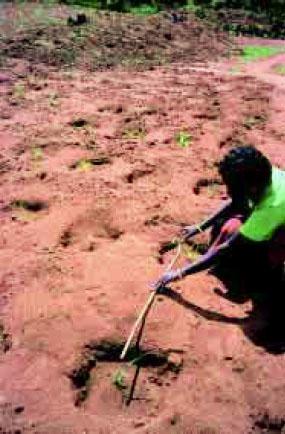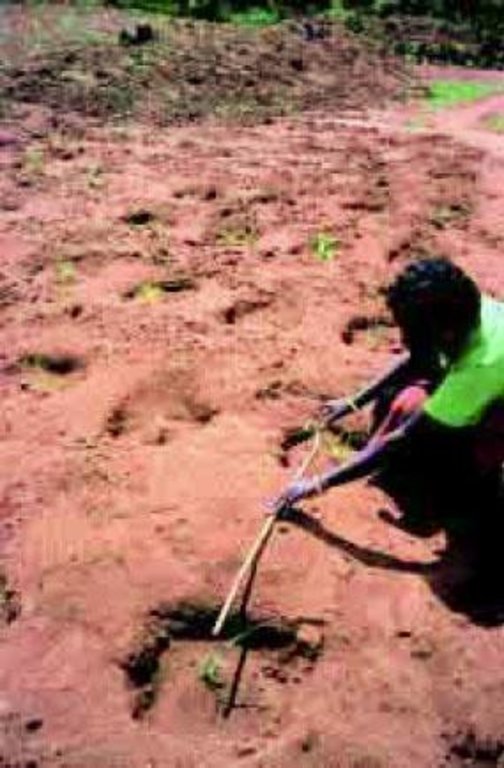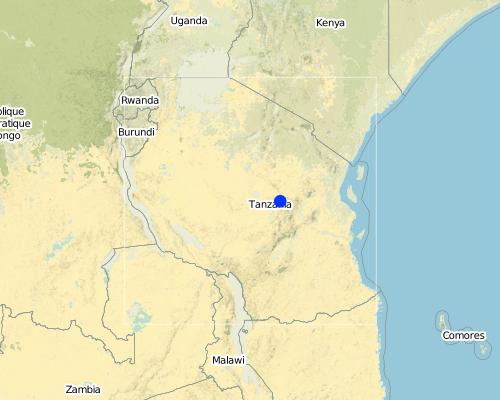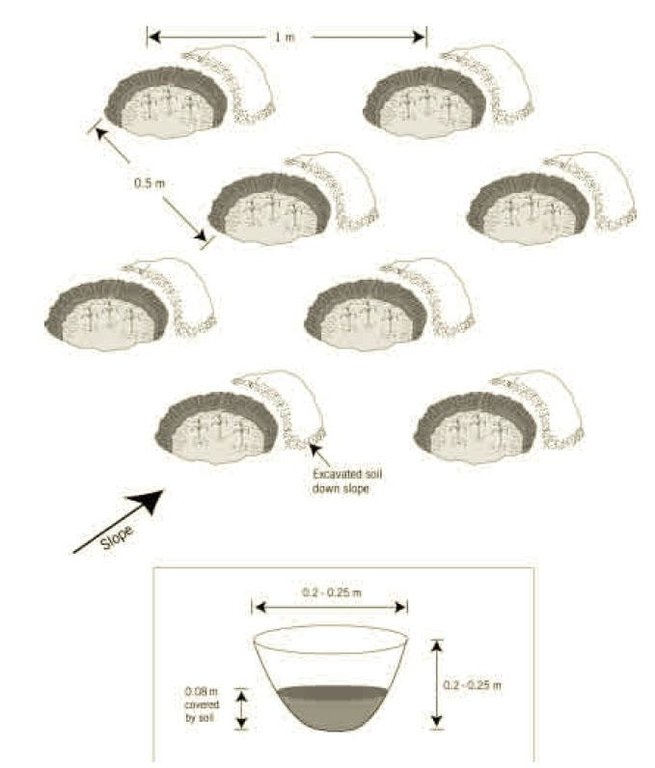Small pit cultivation for maize, sorghum and millet (Chololo pits) [坦桑尼亚联合共和国]
- 创建:
- 更新:
- 编制者: Patrick Gervas Mbanguka Lameck
- 编辑者: –
- 审查者: David Streiff
mashimo ya chololo (Kiswahili)
technologies_1395 - 坦桑尼亚联合共和国
查看章节
全部展开 全部收起1. 一般信息
1.2 参与该技术评估和文件编制的资源人员和机构的联系方式
有助于对技术进行记录/评估的机构名称(如相关)
Inades Formation Tanzania (Inades Formation Tanzania)1.3 关于使用通过WOCAT记录的数据的条件
(现场)数据是什么时候汇编的?:
07/08/2000
编制者和关键资源人员接受有关使用通过WOCAT记录数据的条件。:
是
2. SLM技术的说明
2.1 技术简介
技术定义:
Small planting pits are used for the cultivation of maize, sorghum and millet in order to improve water harvesting
2.2 技术的详细说明
说明:
Pits of about 0.20 - 0.25 m deep and 0.20 - 0.25 m diameter are excavated in lines across the slope. The spacing is approximately 0.5 m from pit centre to pit centre within lines and 1.0 m between lines. During excavation soil is normally heaped below each pit. The spaces between pits are not cultivated. Pits are made during the land preparation period, before the rains. Planting millet seed in the pits follows. Part of the excavated soil is returned to cover the seed, but a depression remains to permit water harvesting. Sungula has a stick – that he shows to visitors - with which he measures depth. Construction of contour bunds to control runoff from outside the plot is carried out in places. There is no strict design, as the farmer is still testing various types. The contour bunds protect the pits (which partially fill with sediment during the season) from excess runoff, and minimise soil erosion.
Purpose of the Technology: The primary purpose is to improve crop production. In terms of soil and water conservation, the moisture status in the soil is raised through water harvesting. Simultaneously, sheet erosion is controlled.
Establishment / maintenance activities and inputs: Pits are generally desilted on an annual basis, but new ones are only constructed, in spaces between the original pits, after a few years. Maintenance is also required for the bunds between the pits.
Natural / human environment: Kenneth Sungula and his family are dependent on his 4 hectares of gently sloping land in Chololo2 village. The family own no livestock, other than a few chickens. They grow millet and cowpeas as their main annual crops. Neither Sungula nor his wife are literate. His novel technology dates back to 1978,
when Sungula stumbled upon the idea by accident. He noted that some plants growing in a small depression in the ground were strongly outperforming others nearby. He then began to experiment by deliberately creating small planting pits. Sungula claims that ‘his stomach taught him’ how to make the pits. His meaning is clear: hunger drove him to find a more productive system of production. These chololo pits, named after the local village, hold runoff, and the spaces between the pits act as micro-catchments. The extra moisture is vital in initial establishment of crops in this semi-arid area, where the first rains can be erratic.
2.3 技术照片
2.5 已应用该技术的、本评估所涵盖的国家/地区/地点
国家:
坦桑尼亚联合共和国
区域/州/省:
Dodoma
有关地点的进一步说明:
Dodoma urban
Map
×2.7 技术介绍
详细说明该技术是如何引入的:
- 通过土地使用者的创新
注释(项目类型等):
Mr Kenneth Sangula is the farmer who developed the technology
3. SLM技术的分类
3.1 该技术的主要目的
- 改良生产
3.2 应用该技术的当前土地利用类型

农田
- 一年一作
主要农作物(经济作物及粮食作物):
major cash crop: Sorghum and millet
major food crop: Maize
other: Groundnuts
注释:
Major land use problems (compiler’s opinion): removal of top soil by gully and sheet erosion
Major land use problems (land users’ perception): poor rainfall, removal of top soil by gully and sheet erosion
3.3 有关土地利用的更多信息
每年的生长季节数:
- 1
具体说明:
Longest growing period in days: 150; Longest growing period from month to month: Nov - Mar
3.4 该技术所属的SLM组
- 集水
3.5 技术传播
具体说明该技术的分布:
- 均匀地分布在一个区域
如果该技术均匀地分布在一个区域上,请注明覆盖的大致区域。:
- 10-100 平方千米
注释:
Total area covered by the SLM Technology is 25 km2.
3.6 包含该技术的可持续土地管理措施

结构措施
- S4:平沟、坑
3.7 该技术强调的主要土地退化类型

土壤水蚀
- Wt:表土流失/地表侵蚀

化学性土壤退化
- Cn:肥力下降和有机质含量下降(非侵蚀所致)

水质恶化
- Ha:干旱化
注释:
Secondary types of degradation addressed: Cn: fertility decline and reduced organic matter content, Ha: aridification
3.8 防止、减少或恢复土地退化
具体数量名该技术与土地退化有关的目标:
- 减少土地退化
4. 技术规范、实施活动、投入和成本
4.1 该技术的技术图纸
4.2 技术规范/技术图纸说明
Chololo planting pits
Location: Dodoma. Tanzania
Technical knowledge required for field staff / advisors: moderate
Technical knowledge required for land users: low
Main technical functions: control of concentrated runoff: retain / trap, water harvesting / increase water supply
Secondary technical functions: control of concentrated runoff: impede / retard, reduction of slope length
Retention/infiltration ditch/pit, sediment/sand trap
Vertical interval between structures (m): 0.9
Spacing between structures (m): 0.3
Depth of ditches/pits/dams (m): 0.9
Width of ditches/pits/dams (m): 0.9
Structural measure: bunds/banks: contour
Vertical interval between structures (m): 0.9
Height of bunds/banks/others (m): 0.4
Width of bunds/banks/others (m): 0.9
Construction material (earth): escavated top soil
Lateral gradient along the structure: 15.00%
4.3 有关投入和成本计算的一般信息
具体说明成本和投入是如何计算的:
- 每个技术区域
注明尺寸和面积单位:
ha
具体说明成本计算所用货币:
- 美元
注明雇用劳工的每日平均工资成本:
1.90
4.4 技术建立活动
| 活动 | 措施类型 | 时间 | |
|---|---|---|---|
| 1. | land clearing, digging pits | 结构性的 | Aug-Oct |
| 2. | sowing and 3'' covering | 结构性的 | Oct |
| 3. | weeding | 结构性的 | dry season |
| 4. | construction of big bunds | 结构性的 | oct-nov |
4.5 技术建立所需要的费用和投入
| 对投入进行具体说明 | 单位 | 数量 | 单位成本 | 每项投入的总成本 | 土地使用者承担的成本% | |
|---|---|---|---|---|---|---|
| 劳动力 | Labour | persons/day/ha | 336.0 | 1.9 | 638.4 | 100.0 |
| 设备 | Tools | ha | 1.0 | 6.25 | 6.25 | 100.0 |
| 肥料和杀菌剂 | Compost / manure | ha | 1.0 | 124.0 | 124.0 | 100.0 |
| 技术建立所需总成本 | 768.65 | |||||
4.6 维护/经常性活动
| 活动 | 措施类型 | 时间/频率 | |
|---|---|---|---|
| 1. | Repair small bunds | 结构性的 | after/3-6 times |
| 2. | construction of protecting bunds | 结构性的 | Oct- Nov/annually |
4.7 维护/经常性活动所需要的费用和投入(每年)
| 对投入进行具体说明 | 单位 | 数量 | 单位成本 | 每项投入的总成本 | 土地使用者承担的成本% | |
|---|---|---|---|---|---|---|
| 劳动力 | Repair small bunds an construction | persons/day/ha | 104.0 | 1.9 | 197.6 | 100.0 |
| 设备 | Tools | ha | 1.0 | 6.25 | 6.25 | 100.0 |
| 肥料和杀菌剂 | Compost / manure | ha | 1.0 | 124.0 | 124.0 | 100.0 |
| 技术维护所需总成本 | 327.85 | |||||
4.8 影响成本的最重要因素
描述影响成本的最决定性因素:
labour affect the cost, soil type also affects the durability of the tools
5. 自然和人文环境
5.1 气候
年降雨量
- < 250毫米
- 251-500毫米
- 501-750毫米
- 751-1,000毫米
- 1,001-1,500毫米
- 1,501-2,000毫米
- 2,001-3,000毫米
- 3,001-4,000毫米
- > 4,000毫米
指定年平均降雨量(若已知),单位为mm:
400.00
农业气候带
- 半干旱
- 干旱
5.2 地形
平均坡度:
- 水平(0-2%)
- 缓降(3-5%)
- 平缓(6-10%)
- 滚坡(11-15%)
- 崎岖(16-30%)
- 陡峭(31-60%)
- 非常陡峭(>60%)
地形:
- 高原/平原
- 山脊
- 山坡
- 山地斜坡
- 麓坡
- 谷底
垂直分布带:
- 0-100 m a.s.l.
- 101-500 m a.s.l.
- 501-1,000 m a.s.l.
- 1,001-1,500 m a.s.l.
- 1,501-2,000 m a.s.l.
- 2,001-2,500 m a.s.l.
- 2,501-3,000 m a.s.l.
- 3,001-4,000 m a.s.l.
- > 4,000 m a.s.l.
关于地形的注释和进一步规范:
Slopes on average: Also gentle
5.3 土壤
平均土层深度:
- 非常浅(0-20厘米)
- 浅(21-50厘米)
- 中等深度(51-80厘米)
- 深(81-120厘米)
- 非常深(> 120厘米)
土壤质地(表土):
- 粗粒/轻(砂质)
- 中粒(壤土、粉土)
表土有机质:
- 低(<1%)
如有可能,附上完整的土壤描述或具体说明可用的信息,例如土壤类型、土壤酸碱度、阳离子交换能力、氮、盐度等。:
Soil fertility is very low - low
Soil drainage / infiltration is medium
Soil water storage capacity is low - very low
5.6 应用该技术的土地使用者的特征
生产系统的市场定位:
- 生计(自给)
- 混合(生计/商业
非农收入:
- 收入的10-50%
相对财富水平:
- 贫瘠
- 平均水平
机械化水平:
- 手工作业
说明土地使用者的其他有关特征:
20% of the land users are average wealthy and own 50% of the land.
65% of the land users are poor and own 40% of the land.
15% of the land users are poor and own 10% of the land.
Off-farm income specification: due to frequent failure, farmer embark on other income generating activities such as local brew making hunting charcoal making and provision of cheap labour to successful farmers
Market orientation of production system: Crop performance is poor for subsistence
Level of mechanization: No machinery
5.7 应用该技术的土地使用者拥有或租用的平均土地面积
- < 0.5 公顷
- 0.5-1 公顷
- 1-2 公顷
- 2-5公顷
- 5-15公顷
- 15-50公顷
- 50-100公顷
- 100-500公顷
- 500-1,000公顷
- 1,000-10,000公顷
- > 10,000公顷
注释:
harvest of 0-3 bag/acre
5.8 土地所有权、土地使用权和水使用权
土地所有权:
- 州
- 个人,未命名
土地使用权:
- 社区(有组织)
- 租赁
6. 影响和结论性说明
6.1 该技术的现场影响
社会经济效应
生产
作物生产
收入和成本
农业收入
工作量
社会文化影响
社区机构
国家机构
SLM/土地退化知识
生态影响
水循环/径流
多余水的排放
土壤
土壤水分
土壤覆盖层
土壤流失
减少气候和灾害风险
风速
其它生态影响
soil fertility
biodiversity
6.2 该技术的场外影响已经显现
旱季稳定可靠的水流
下游洪水
下游淤积
6.4 成本效益分析
技术收益与技术建立成本相比如何(从土地使用者的角度看)?
短期回报:
积极
长期回报:
非常积极
技术收益与技术维护成本/经常性成本相比如何(从土地使用者的角度看)?
短期回报:
稍微积极
长期回报:
积极
6.5 技术采用
- 大于 50%
如若可行,进行量化(住户数量和/或覆盖面积):
400 households covering 85 percent of the area stated (60 percent of all land users)
在所有采用这项技术的人当中,有多少人是自发地采用该技术,即未获得任何物质奖励/付款?:
- 90-100%
注释:
400 land user families have adopted the Technology without any external material support
Comments on spontaneous adoption: estimates
There is a strong trend towards spontaneous adoption of the Technology
Comments on adoption trend: The spread of this pitting technology has been quite rapid. The latest figures put the number of adopters at just over 300, though apparently it is mainly men who have taken to the system according to estimates. Most of this has occurred since systematic visits were organized by the project.
6.7 该技术的优点/长处/机会
| 土地使用者眼中的长处/优势/机会 |
|---|
| same as above |
| 编制者或其他关键资源人员认为的长处/优势/机会 |
|---|
|
ability to harvest rain How can they be sustained / enhanced? construct big contour bunds |
|
ability to store water How can they be sustained / enhanced? ensure no water escapes |
|
ability to enable safe application of fym and compost How can they be sustained / enhanced? use mapambano compost developed by mama Suzana |
6.8 技术的弱点/缺点/风险及其克服方法
| 土地使用者认为的弱点/缺点/风险 | 如何克服它们? |
|---|---|
| same as above |
| 编制者或其他关键资源人员认为的弱点/缺点/风险 | 如何克服它们? |
|---|---|
| tough job | use of shovels |
| dry spells have negative impacts | increases size of pits after research |
7. 参考和链接
7.2 参考可用出版物
标题、作者、年份、ISBN:
Kithinji M., Critchley W. 2001. Farmers' initiatives in land husbandry: Promising technologies for the drier areas of East Africa. RELMA Technical Report series no. 27
链接和模块
全部展开 全部收起链接
无链接
模块
无模块





